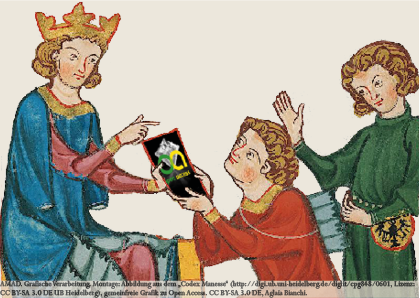AMAD
„Archivum Medii Aevi Digitale - Interdisziplinäres Open-Access-Fachrepositorium und Wissenschaftsblog für Mittelalterforschung‟Zur Einreichung

Langanzeige der Metadaten
| DC Element | Wert | Sprache |
|---|---|---|
| Autor*in | Manikowska, Halina | - |
| Autor*in | Slon, Marek | - |
| Datum | 2017 | - |
| Quelle | http://apcz.umk.pl/czasopisma/index.php/BPMH/article/view/BPMH.2017.003 | - |
| Quelle | https://doi.org/10.12775/BPMH.2017.003 | - |
| URI | https://www.amad.org/jspui/handle/123456789/162458 | - |
| URI | http://opac.regesta-imperii.de/id/2387012 | - |
| Zusammenfassung | Die Autoren unterscheiden den Begriff „sakrale Geographie“ von den Bezeichnungen „sakrale Topografie“ und „kirchliche Topografie“ (als institutionell-soziale). Im Artikel wurde dann die Bedeutung der Perzeption von Raum und Zeit betont, eine Analyse der Zusammenhänge zwischen diesen Kategorien durchgeführt und das symbolische Aufscheinen des Heiligen im Profanen (Hierophanie) überlegt. Die sakrale Geographie wurde damit als eine Kategorie sozialer Vorstellungen, Praxis, und Perzeption genannt, die in zumindest wesentlichem Maße Einfluss auf die Gestalt der Stadt hat. Die Autoren berufen sich auf die Beispiele der berühmtesten (heiligsten) Städte: Jerusalem, Rom und Aachen und ihren Einfluss auf die Städte Ostmitteleuropas. ; More than Two Dimensions: The Sacred Geography of the Medieval Town “Inside” and “Upwards” The authors distinguish the term “sacred geography” from the terms “sacred topography” and “church topography” (in the institutional-social sense). The article underlines the importance of the perception of space and time; it includes the analysis of the relations between those categories and analyzes the phenomena of social images, practices and perceptions, which affect the town. The authors refer to the examples of the most famous (the most holy) towns of Jerusalem, Rome and Aachen and their influence on the towns in Central and Eastern Europe. ; Ponad dwa wymiary. Geografia sakralna miasta średniowiecznego „do wewnątrz” oraz „wzwyż” Autorzy odróżniają pojęcie „geografia sakralna” od określeń „topografia sakralna” i „topografia kościelna” (w znaczeniu „instytucjonalno-społecznym”). W artykule podkreślono więc znacznie percepcji przestrzeni i czasu, przeprowadzono analizę relacji między tymi kategoriami oraz rozważano zjawiska symbolicznej manifestacji sacrum (hierofania). Geografia sakralna jest tu rozumiana jako kategoria społecznych wyobrażeń, praktyki i percepcji, która w stopniu co najmniej znaczącym wpływa na kształt miasta. Autorzy odwołują się do przykładów najsłynniejszych (najświętszych) miast: Jerozolimy, Rzymu i Akwizgranu i ich oddziaływania na miasta Europy Środkowo-Wchodniej. | - |
| Format | 75-104 | - |
| Sprache | ger | - |
| Relation | Bulletin der Polnischen Historischen Mission | - |
| Schlagwörter | Mittelalter | - |
| Schlagwörter | Slon, Marek (20. Jh.) | - |
| Dewey-Dezimalklassifikation | 940 | - |
| Titel | Über zwei Dimensionen hinaus Die sakrale Geographie der mittelalterlichen Stadt "nach innen" und "nach oben" | - |
| Typ | Aufsatz | - |
| AMAD ID | 2387012 | - |
| Enthalten in den Sammlungen: | General history of Europe Regesta Imperii - Literaturdatenbank | |
Dateien zu dieser Ressource:
Es gibt keine Dateien zu dieser Ressource.
Alle Ressourcen in diesem Repository sind urheberrechtlich geschützt, soweit nicht anderweitig angezeigt.

